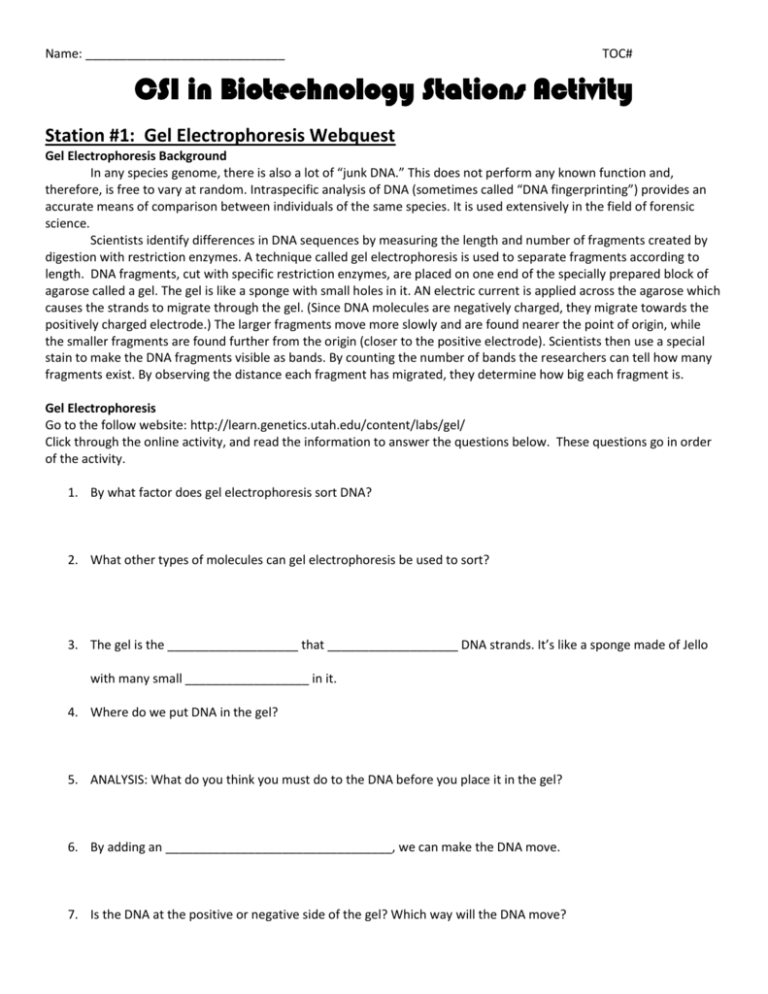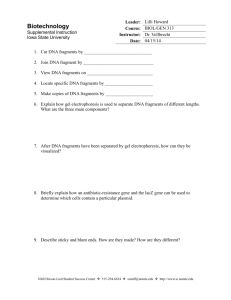Gel Electrophoresis Webquest
advertisement

Name: _____________________________ TOC# CSI in Biotechnology Stations Activity Station #1: Gel Electrophoresis Webquest Gel Electrophoresis Background In any species genome, there is also a lot of “junk DNA.” This does not perform any known function and, therefore, is free to vary at random. Intraspecific analysis of DNA (sometimes called “DNA fingerprinting”) provides an accurate means of comparison between individuals of the same species. It is used extensively in the field of forensic science. Scientists identify differences in DNA sequences by measuring the length and number of fragments created by digestion with restriction enzymes. A technique called gel electrophoresis is used to separate fragments according to length. DNA fragments, cut with specific restriction enzymes, are placed on one end of the specially prepared block of agarose called a gel. The gel is like a sponge with small holes in it. AN electric current is applied across the agarose which causes the strands to migrate through the gel. (Since DNA molecules are negatively charged, they migrate towards the positively charged electrode.) The larger fragments move more slowly and are found nearer the point of origin, while the smaller fragments are found further from the origin (closer to the positive electrode). Scientists then use a special stain to make the DNA fragments visible as bands. By counting the number of bands the researchers can tell how many fragments exist. By observing the distance each fragment has migrated, they determine how big each fragment is. Gel Electrophoresis Go to the follow website: http://learn.genetics.utah.edu/content/labs/gel/ Click through the online activity, and read the information to answer the questions below. These questions go in order of the activity. 1. By what factor does gel electrophoresis sort DNA? 2. What other types of molecules can gel electrophoresis be used to sort? 3. The gel is the ___________________ that ___________________ DNA strands. It’s like a sponge made of Jello with many small __________________ in it. 4. Where do we put DNA in the gel? 5. ANALYSIS: What do you think you must do to the DNA before you place it in the gel? 6. By adding an _________________________________, we can make the DNA move. 7. Is the DNA at the positive or negative side of the gel? Which way will the DNA move? 8. Which strands will move the farthest, why? 9. We can’t see a single strand of stained DNA, but we can see ____________________________. 10. What causes the bands in the gel? In the following questions, follow along completing the steps of running a gel, and answer these questions. 11. Make the gel in step 1. What are the ingredients of agarose gel? 12. What does the liquid buffer do? 13. As the gel cools, ________________________ will form in it. 14. What is the comb for? 15. Why do we use the DNA Size Standard? 16. In the last step, the stain we use on the DNA is a chemical that _________________ to DNA and shows up under __________________________ light. 17. Although we can’t see ____________________ DNA strands, we can see large groups of stained DNA strands. These groups will show up as bands in the gel. 18. How many base pairs long was each of the three bands of DNA that showed up? 19. ANALYSIS: explain, in detail, why we use gel electrophoresis. Station #2: Using DNA in Crime 1. What is the picture to the right showing? 2. Who else should the investigators be comparing the DNA to? 3. Which suspect is should be arraigned based on this information? 4. What do the different bands represent? Read the “Innocent or Guilty?” Reading and then answer the question. 5. Should there be a national or international DNA database of all our DNA profiles to help police identify criminals from the clues – blood, skin, saliva, semen, faeces – that they leave behind at almost every crime scene? Read the “Familial Searching” reading and then answer the question. 6. What is “familial searching”? 7. Currently, our state uses familial searching to identify possible suspects in certain cases. Do you agree with our state using this method. Why or why note? Station #3: DNA Double Take Article Directions: Read the article at this station. Answer the following questions after reading the article. 8. What can genome sequencing be used for? 9. What is chimerism? Give an example. 10. What are some different ways that people can acquire different genomes? 11. What is mosaicism? Give an example. 12. Give an example of how chimeras are helpful. 13. Give an example of how chimeras are harmful. 14. What are the implications for humans having different genomes in their body in terms of testing, such as blood tests? 15. What are the implications that could arise with this new information in terms of using DNA in the justice system?





![Student Objectives [PA Standards]](http://s3.studylib.net/store/data/006630549_1-750e3ff6182968404793bd7a6bb8de86-300x300.png)

